How to Prepare Ackee Fruit? 9 Easy Steps!
Ackee, the national fruit of Jamaica, is a distinctive ingredient integral to the cuisine of the Caribbean. Preparing ackee requires precision, as improper handling can result in the presence of toxins.
The fruit must be allowed to ripen and open naturally on the tree to signal readiness for consumption. Upon harvesting, one must carefully remove the inedible black seeds and the pink lining, which are toxic.
Prior to cooking, thorough cleaning and pre-boiling are crucial steps to ensure safety and enhance flavor.
This guide provides a comprehensive overview of the processes involved in preparing ackee, from selecting the ripe fruit to the final culinary preparations, and includes essential tips to mitigate toxicity risks.
Attention to these details ensures a safe and enjoyable experience with this unique and flavorful fruit.
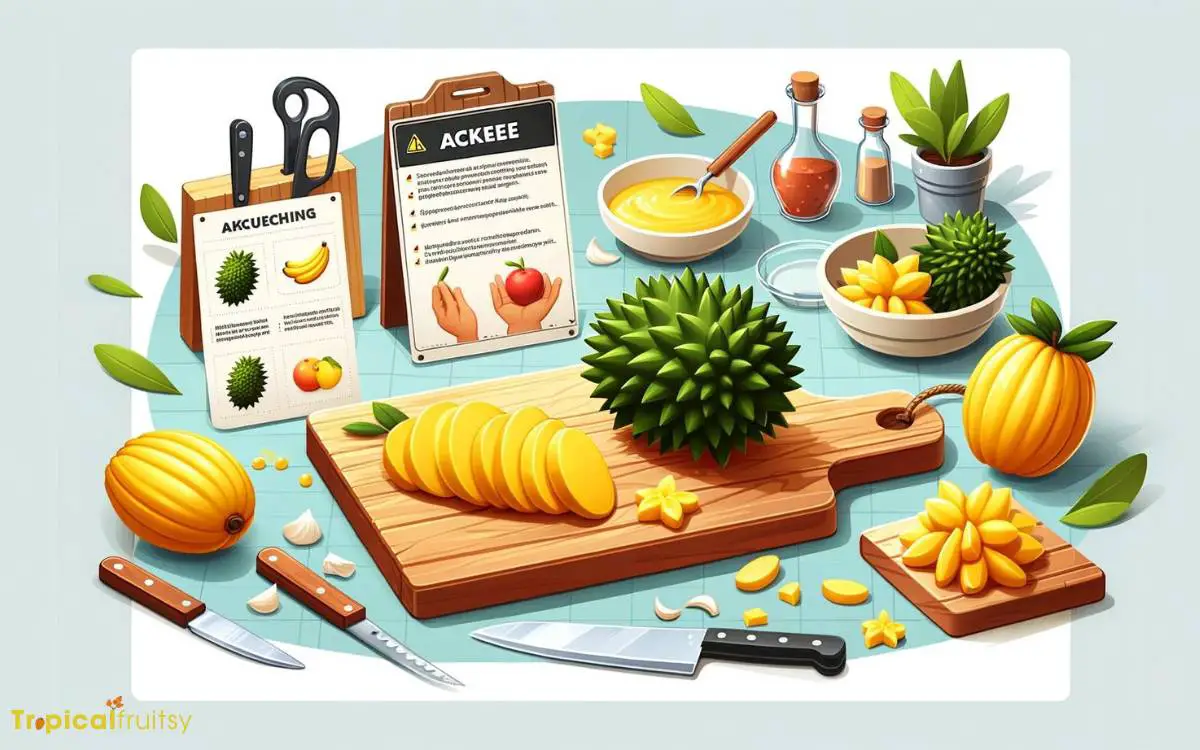
Key Takeaway
Step 1: Identifying Ripe Ackee

Before attempting to prepare ackee fruit, it is crucial to ascertain that each pod has naturally opened on the tree, signifying ripeness.
Ackee, the national fruit of Jamaica, is renowned for its rich flavor and unique texture. However, unripe ackee contains toxic substances that can cause severe health problems, a condition known as ‘Jamaican Vomiting Sickness.’
This underscores the importance of identifying ripe ackee, which is safe to consume.
A ripe ackee pod will split open to reveal three large, shiny black seeds, each surrounded by soft, yellow to cream-colored flesh. This visual cue is a reliable indicator of maturity and safety for consumption.
With this knowledge, one can proceed with confidence to the next critical step: harvesting the fruit safely.
Step 2: Harvesting the Fruit Safely
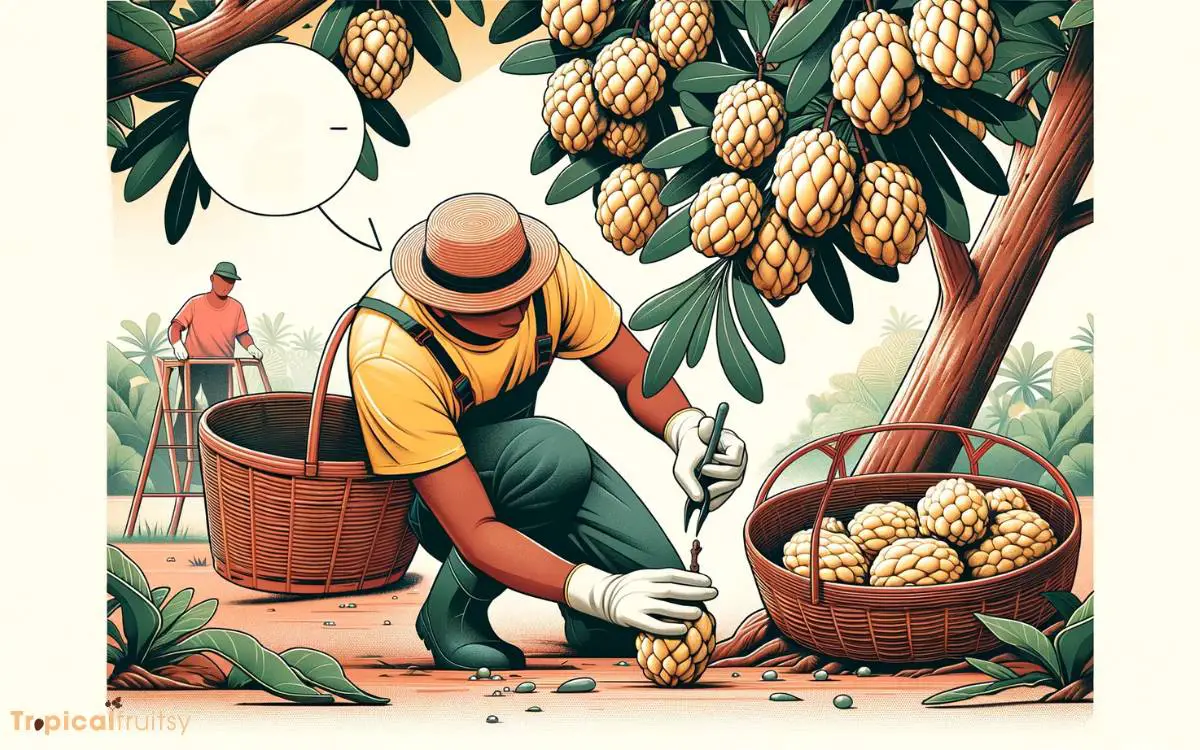
Having identified ripe ackee pods that have naturally opened, the next step is to harvest the fruit carefully to ensure safety and maintain its quality.
It is crucial to collect ackee without disturbing the ones that have not yet opened, as these are not safe for consumption due to premature levels of toxic hypoglycin.
Wearing gloves, gently remove the arils, which are the edible portions, avoiding the seeds and any unripened parts. It’s advisable to harvest during dry conditions to prevent moisture from compromising the fruit’s integrity.
Once collected, the arils should be washed thoroughly in clean water to remove any external contaminants.
Exercising these precautions will yield safe, ready-to-prepare ackee that retains its nutritional benefits and authentic flavor.
Step 3: Initial Cleaning Process
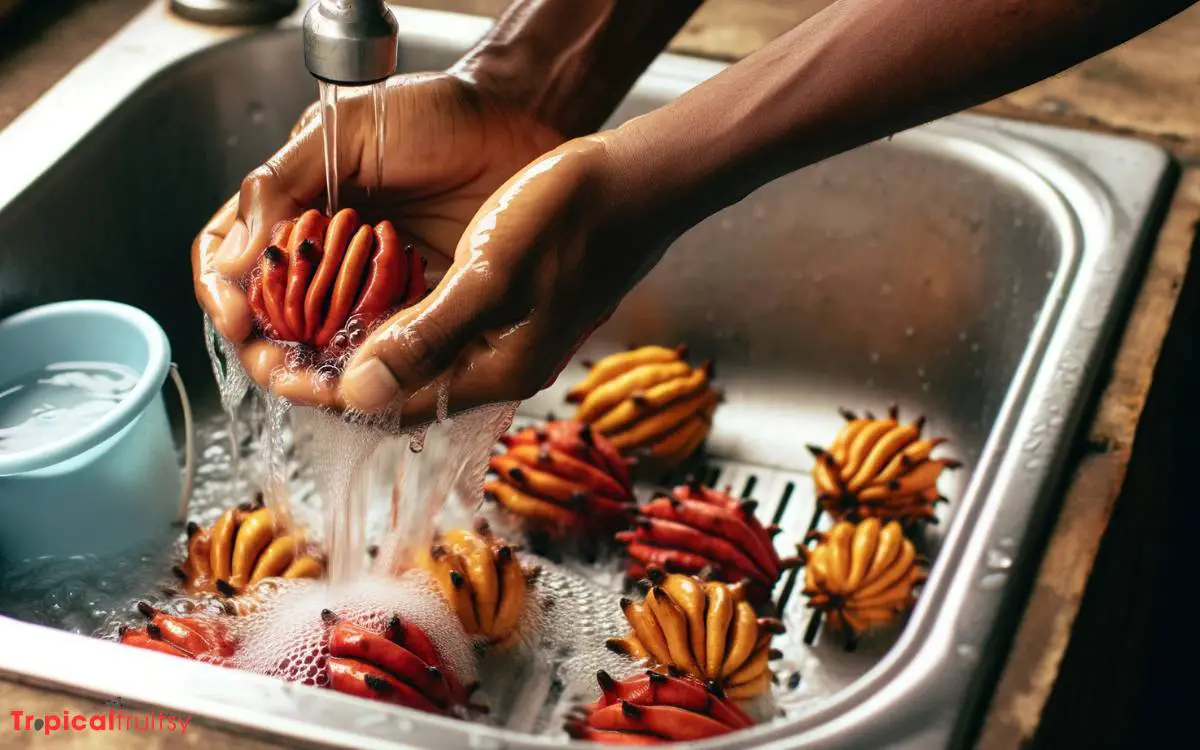
The initial cleaning process involves carefully rinsing the harvested ackee arils under cool, running water to eliminate any dirt or foreign matter.
This step is crucial in ensuring the safety and cleanliness of the fruit before it is consumed or cooked.
Take each aril and gently wash it, paying close attention to crevices where contaminants can hide. It is advisable to perform this cleaning meticulously, as the ackee’s unique structure can harbor unwanted residues.
Once rinsed, inspect the arils for any signs of spoilage or infestation. Discard any that do not meet the standard of quality.
This attention to detail not only ensures the purity of the fruit but also respects the traditional practices associated with ackee preparation.
Step 4: Removing Seeds and Membranes
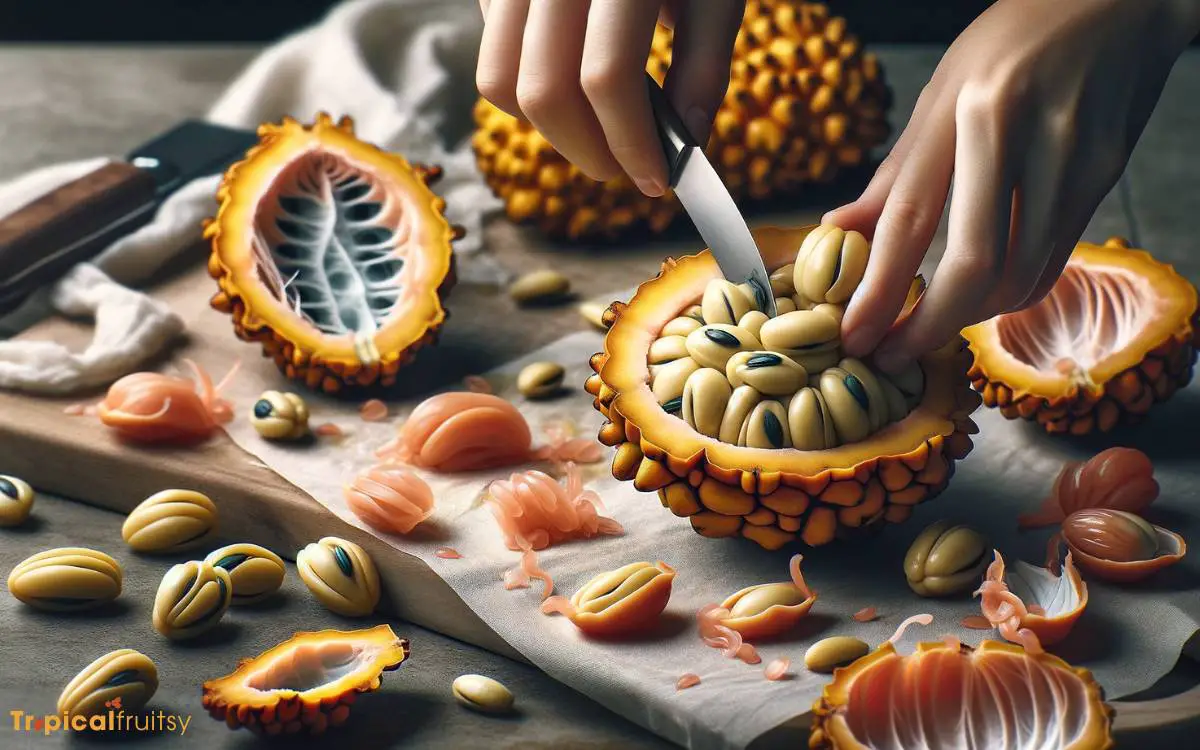
Once the ackee fruit has been cleansed, attention must be turned to the critical step of removing the seeds and inner membranes. It is imperative to handle this stage with care, as improper removal can lead to exposure to the fruit’s natural toxins.
Safe Seed Extraction
Seed extraction, a critical step in ackee preparation, involves cautiously removing the fruit’s toxic seeds and inner membranes to ensure safe consumption.
Begin this process only when the ackee pods have naturally split open; forcing them open prematurely can lead to potential toxicity.
Gently separate the yellow arilli, the edible portions, from the black seeds and any attached red fibers, which are the toxic membranes.
Using a small, sharp knife, delicately cut away these non-edible parts, taking care not to pierce the flesh of the fruit itself.
Discard the seeds and membranes immediately and thoroughly wash your hands afterward to avoid any contamination.
Always perform this task with meticulous attention, as proper removal of these components is paramount for the safety and enjoyment of the cooked ackee dish.
Membrane Removal Techniques
How can one ensure the complete and safe removal of the toxic membranes attached to the ackee seeds? It’s crucial to handle this step with care to avoid any remnants of the potentially harmful substance.
An effective technique involves gentle separation using clean fingertips or a small, blunt tool to tease away the membrane without damaging the tender flesh of the fruit.
| Step | Instructions |
|---|---|
| 1 | Wait for the ackee pods to open naturally. |
| 2 | Twist and remove the seeds from the open pods. |
| 3 | Identify the pinkish membranes attached to the seeds. |
| 4 | Carefully peel away membranes from the ackee flesh. |
| 5 | Ensure no traces of membrane remain on the fruit. |
Preventing Toxin Exposure
Initiate the ackee preparation process by meticulously discarding the seeds and carefully extracting the attached membranes to prevent exposure to the fruit’s naturally occurring toxins.
Ackee contains hypoglycin A, which can be harmful if ingested before the fruit is fully ripe or if the toxic parts are not removed properly.
To ensure safety:
- Only use ackees that have naturally split open on the tree.
- Avoid ackees that are forced open as they may be underripe and toxic.
Steps to remove toxins:
- Wear gloves to minimize direct contact with any toxic components.
- Gently separate the yellow aril (edible portion) from the pinkish membranes and black seeds.
- Dispose of the seeds and membranes immediately and safely.
This meticulous approach is crucial for a safe and enjoyable ackee dish.
Step 5: Pre-Boiling Procedures
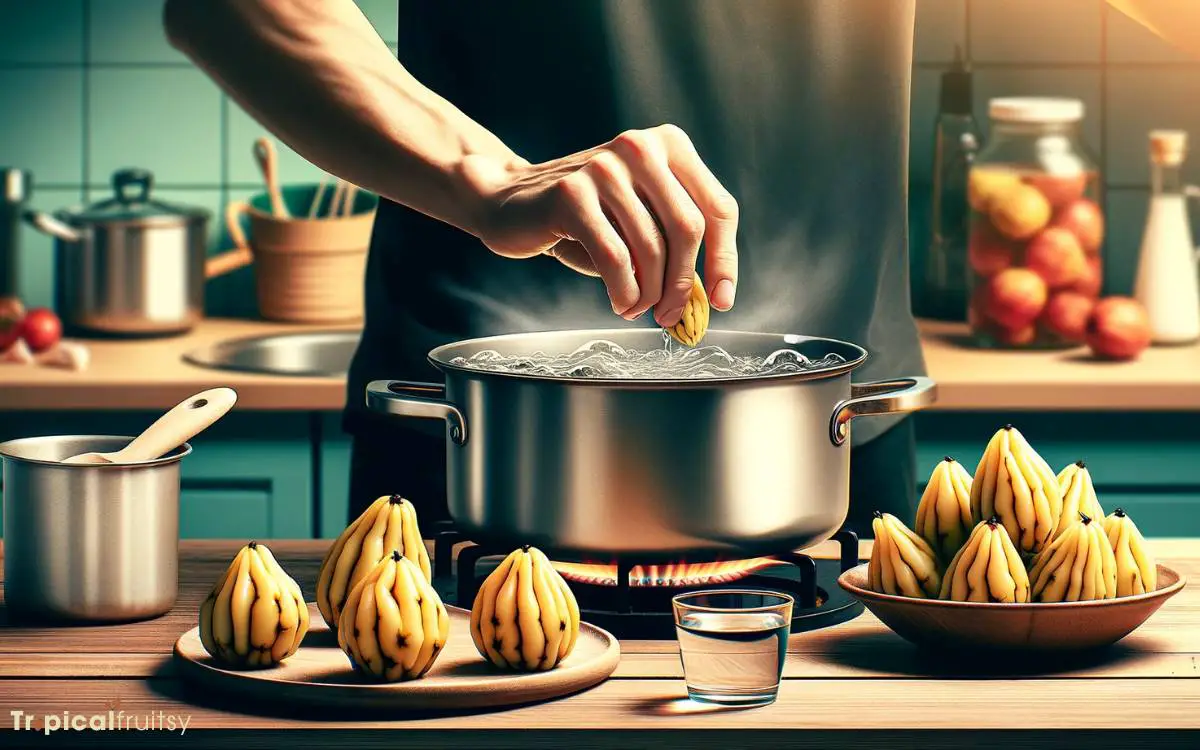
Before boiling ackee, it is imperative to ensure that the fruit is properly prepared to guarantee both safety and flavor.
The process begins with the selection of fully ripe ackee, which is then meticulously cleaned and washed to remove any external contaminants.
Special attention must be paid to the removal of the toxic parts, including the inedible seeds and the pink lining, which if not discarded, can render the fruit dangerous to consume.
Selecting Ripe Ackee
One must exercise caution when selecting ackee fruit, ensuring it is fully ripe to avoid the presence of toxic hypoglycin. The ripeness of ackee is a critical factor for safe consumption and optimal flavor.
To discern the maturity of ackee, pay attention to the following indicators:
Color and Opening:
- Look for bright red to yellow-orange ackees.
- Ensure the ackees have naturally split open, revealing the seeds and yellow arils.
Touch and Texture:
- The fruit should yield slightly to gentle pressure.
- The opened sections should reveal a soft, spongy aril that is free from any signs of mold or decay.
Selecting ackee with care is paramount for both safety and culinary success.
Cleaning and Washing
After selecting the ripe ackee fruit, it is essential to thoroughly clean and wash the arils and seeds to remove any external contaminants before proceeding to the boiling stage.
Begin by discarding any open pods that do not naturally reveal the arils and seeds, as forced opening may suggest under-ripeness and potential toxicity.
Next, rinse the arils under clean, running water to wash away dirt and debris. Use a soft brush if necessary to gently scrub the surface.
| Step | Description | Tips |
|---|---|---|
| 1 | Discard unsuitable pods | Only use naturally opened pods |
| 2 | Rinse arils and seeds | Use running water |
| 3 | Gently scrub surface | Soft brush recommended |
Following these steps ensures the ackee is clean and safe for the subsequent boiling process, which is critical for eliminating any remaining toxins.
Removing Toxic Parts
Following the thorough cleaning of the ackee arils, it is imperative to remove the seeds and any traces of the pink membrane, as these parts contain the toxin hypoglycin A, which must be eliminated prior to cooking.
Carefully performing this step ensures the safety and edibility of the fruit.
Here’s how to proceed:
Examine each aril closely:
- Look for any remnants of the pink membrane.
- Ensure that the black seeds are entirely removed.
Use appropriate tools:
- A small, sharp knife can be effective for excising unwanted parts.
- Employ gentle pressure to avoid damaging the edible portion of the arils.
This meticulous approach is crucial for rendering the ackee safe for consumption and guarantees that the culinary experience is not only authentic but also secure.
Step 6: Cooking Ackee Properly
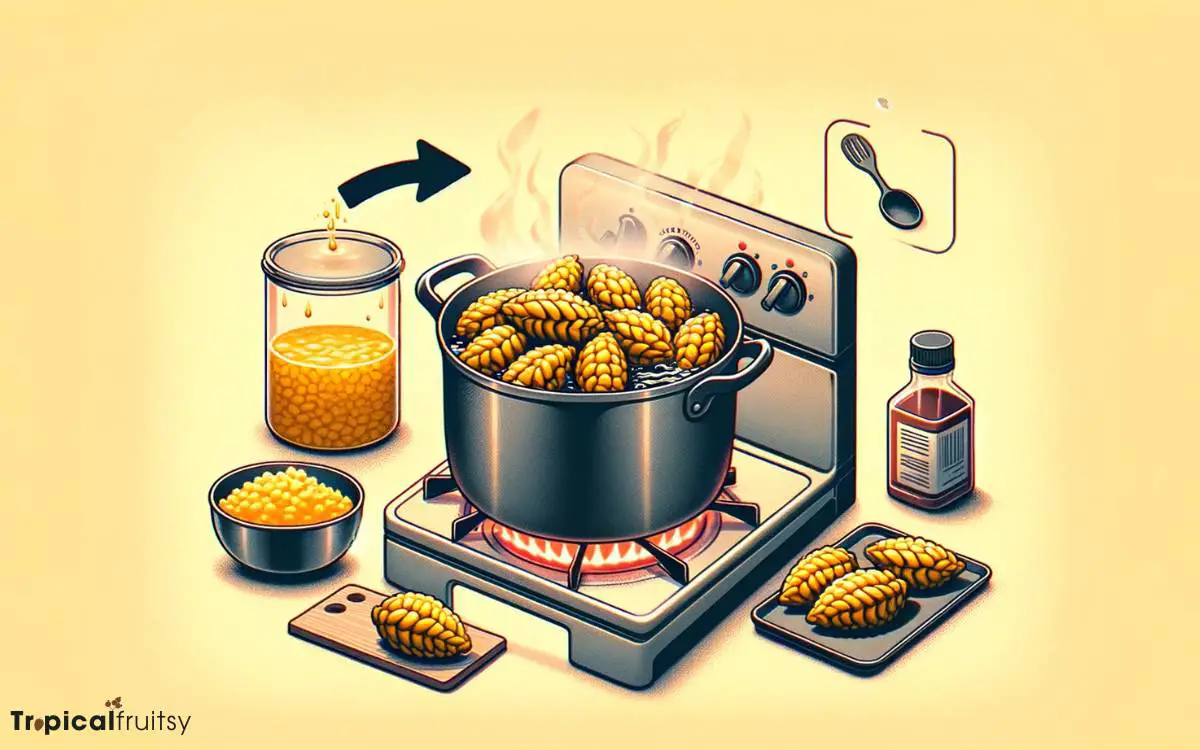
Begin cooking ackee by ensuring that the fruit has been properly cleaned and is free from any remnants of the toxic red membrane that encases the edible yellow portions.
Once prepped, traditionally, ackee is boiled in water for about 5 to 10 minutes or until it is tender. It is crucial to boil the fruit to eliminate any lingering toxicity.
As the ackee cooks, it should be watched carefully to prevent it from becoming mushy, which can happen quite quickly.
After boiling, the ackee can be drained and added to various dishes, often sautéed with seasonings and other ingredients like saltfish, a classic Jamaican pairing.
Step 7: Tips for Avoiding Toxicity
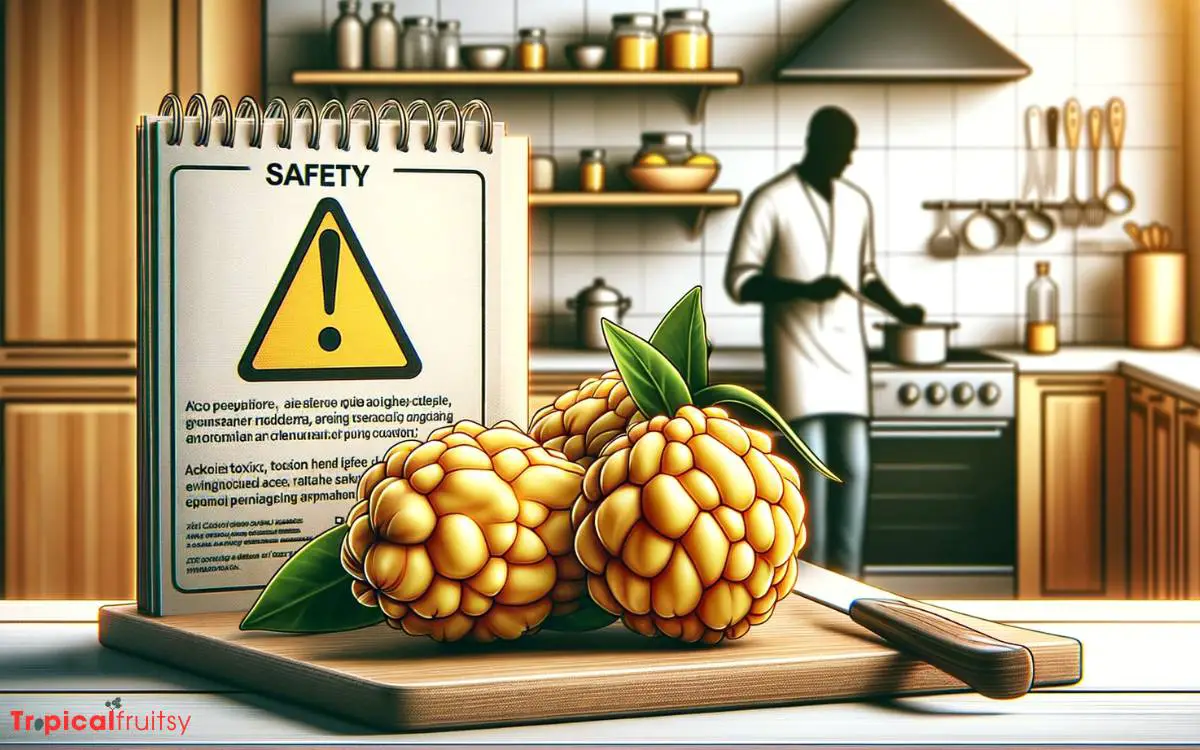
Always ensure that ackee fruit is fully ripe and naturally opened before harvesting to prevent the risk of toxicity. The unripe fruit contains hypoglycin A, a toxin that can cause severe health issues.
To mitigate this risk, consider the following guidelines:
- Choose ackee that has naturally split open.
- Unsplit ackees are not ready for consumption.
- Forced opening can lead to the ingestion of toxic substances.
Carefully remove the seeds and all traces of the inner red membrane:
- These parts contain the highest levels of toxins.
- Proper cleaning ensures the safety of the dish.
Step 8: Serving Suggestions
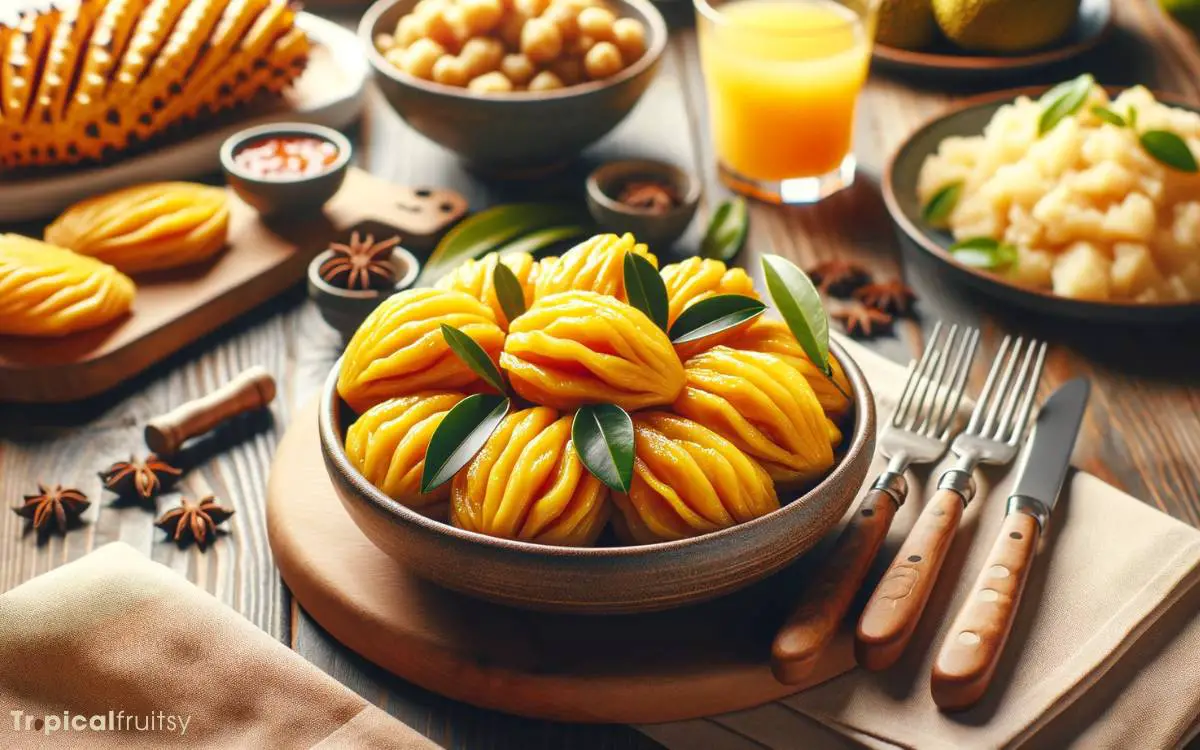
Traditionally, ackee is often served with saltfish, creating Jamaica’s national dish, which is both flavorful and rich in protein.
This dish exemplifies the fusion of indigenous and imported culinary traditions that define Caribbean cuisine. Ackee, when prepared correctly, can complement a variety of dishes beyond its classic pairing.
Below is a table offering serving suggestions for incorporating ackee into meals:
| Dish Type | Serving Suggestion |
|---|---|
| Breakfast | Scrambled with eggs and bell peppers |
| Lunch | Mixed into a tropical salad with avocado and mango |
| Dinner | As a side with jerk chicken and rice |
These ideas showcase ackee’s versatility and allow those unfamiliar with the fruit to integrate it into familiar meal structures. Remember to always ensure the fruit is fully ripe and properly prepared before consuming.
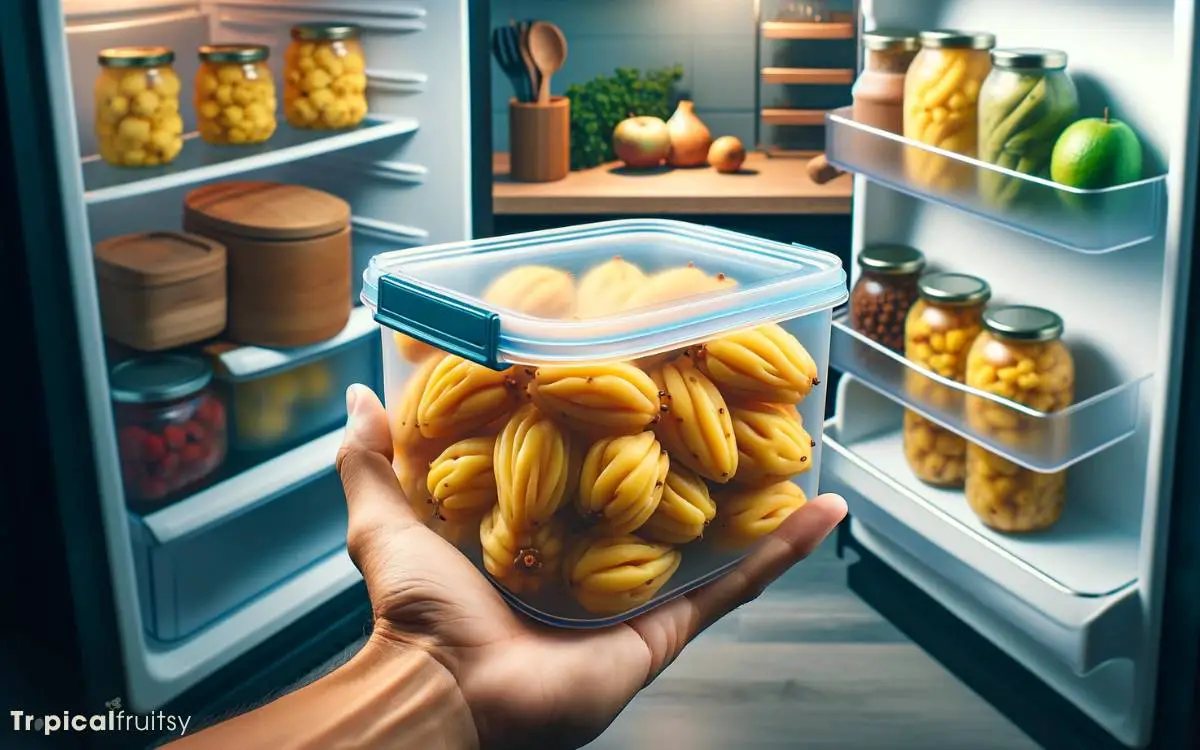
Step 9: Storing Leftover Ackee
Once you have enjoyed your meal, any remaining ackee should be stored promptly and correctly to maintain its freshness and safety.
To ensure that the ackee remains suitable for consumption, adhere to the following storage guidelines:
Refrigerate:
- Place ackee in an airtight container to prevent it from absorbing odors from other foods.
- Consume refrigerated ackee within 3-5 days for optimal freshness.
Freeze:
- For longer preservation, ackee can be frozen. Ensure it is sealed in a freezer-safe bag or container.
- Thaw in the refrigerator before reuse, and never refreeze previously frozen ackee.
Why is it important to properly prepare ackee fruit before consumption?
Properly preparing ackee fruit before consumption is crucial because consuming it improperly can lead to a condition known as “Jamaican vomiting sickness.” This occurs due to the presence of toxins in the fruit, which can cause severe illness. Understanding the correct way to handle ackee fruit versus vegetable is essential for safe consumption.
How to Eat Ackee Fruit
Eating ackee, the national fruit of Jamaica and a key ingredient in the famous Jamaican dish ackee and saltfish, requires careful preparation due to its potentially toxic properties when not properly ripe or prepared.
Here’s how to safely eat ackee fruit:
Identifying Ripe Ackee
- Wait for the Ackee to Open Naturally: Ackee must be allowed to ripen on the tree and open naturally. The ripe fruit splits open to reveal three large, shiny black seeds, each surrounded by soft, yellow, edible arils (the edible portion). Unripe ackee is toxic.
- Look for the Right Color: The edible part of the ackee should be bright yellow to yellow-orange, and it should easily separate from the seed and the pod.
Preparing Ackee
- Remove the Seeds and Membrane: Carefully remove the black seeds and any traces of the inner red membrane, as these parts are toxic. You should be left with only the yellow arils.
- Wash Thoroughly: Wash the arils thoroughly in cold water.
- Boil the Ackee: Boil the ackee in water for about 20-30 minutes. This is a crucial step as it removes any remaining toxins. The ackee is ready when it becomes tender and bright yellow.
- Drain Well: Once boiled, drain off the water completely.
Cooking Ackee
- Ackee and Saltfish: The most popular way to eat ackee is in the dish ackee and saltfish. This involves sautéing the boiled ackee with salted codfish (which has been soaked overnight to remove some of the salt), onions, scallions, peppers, tomatoes, and spices.
- Other Dishes: Ackee can also be used in other dishes, similar to how you might use scrambled eggs or tofu.
Consumption Tips
- Never Eat Raw Ackee: Consuming unripe or improperly prepared ackee can lead to “Jamaican Vomiting Sickness,” caused by hypoglycin A and hypoglycin B toxins. Symptoms include severe vomiting, hypoglycemia, and can even be fatal.
- Purchase Canned Ackee If Outside Jamaica: If you’re not in Jamaica, it’s safer to buy canned ackee, which is pre-cooked and ready to be used in dishes. Canned ackee is widely available in international or Caribbean food markets.
Ackee, when properly prepared, is delicious and safe. It has a creamy, mild flavor and a texture similar to scrambled eggs.
Always ensure you’re familiar with the proper preparation techniques before attempting to cook fresh ackee.
Conclusion
The meticulous preparation of ackee—balancing culinary tradition with health precautions—underscores its cultural significance alongside the imperative of safety.
While its preparation may seem daunting, the result is a delicacy that rewards the careful cook with a unique and flavorful experience.
Thus, the ritual of preparing ackee not only preserves a culinary heritage but also exemplifies a profound respect for the intricate interplay between nature’s provisions and human well-being.






